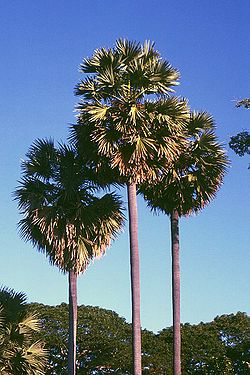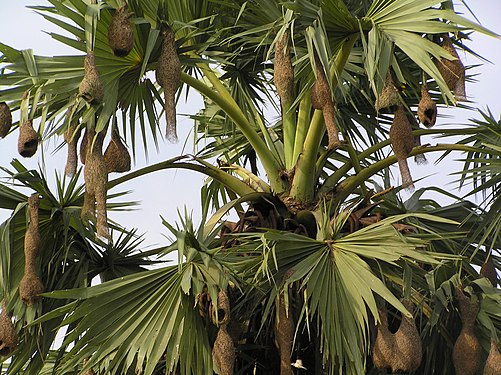Difference between revisions of "Borassus flabellifer"
(Created page with '{{SPlantbox |genus=Borassus |species=flabellifer |Temp Metric=°F |jumpin=If this plant info box on watering; zones; height; etc. is mostly empty you can click on the edit tab a…') |
|||
| Line 1: | Line 1: | ||
{{SPlantbox | {{SPlantbox | ||
| − | |genus=Borassus | + | |genus=Borassus |
|species=flabellifer | |species=flabellifer | ||
| + | |features=edible, fruit | ||
|Temp Metric=°F | |Temp Metric=°F | ||
|jumpin=If this plant info box on watering; zones; height; etc. is mostly empty you can click on the edit tab and fill in the blanks! | |jumpin=If this plant info box on watering; zones; height; etc. is mostly empty you can click on the edit tab and fill in the blanks! | ||
| − | |image= | + | |image=Tree I IMG 1497.jpg |
| − | |image_width= | + | |image_width=180 |
}} | }} | ||
| + | '''''Borassus flabellifer''''', also known as the Asian palmyra palm, [[Toddy palm]], [[sugar palm]], or Cambodian palm, is robust and can live 100 years or more and reach a height of 30 m, with a canopy of leaves several dozen fronds spreading 3 meters across. The large trunk resembles that of the [[coconut tree]] and is ringed with leaf scars. Young palmyra palms grow slowly in the beginning but then grow faster. Its growth pattern, large size, and clean habits make it an attractive [[landscape]] species. | ||
| + | |||
| + | The fruit measures 4 to 7 inches in diameter, has a black [[husk]], and is borne in clusters. The top portion of the fruit must be cut off to reveal the three sweet jelly seed sockets, translucent pale-white, similar to that of the [[lychee]] but with a milder flavor and no pit. The jelly part of the fruit is covered with a thin, yellowish-brown skin. The ripened fibrous outer layer of the palm fruits can also be eaten raw, boiled, or roasted. | ||
| + | |||
{{Inc| | {{Inc| | ||
Borassus flabellifer, Linn. (B. flabelliformis, Mutt. B. aethiopium, Mart.). Meelalla, a native name for young plants; called also Palmyra Palm by the Hindoos. Fig. 593. St. 60-70 ft. high: Lvs. 8-10 ft. long, broader than long; lf-segms. bifid at the apex, lanceolate or sword- shaped in outline.—Widely cult. One of the most useful palms of India. The frs. are very large. Many parts of the plant are utilized by the natives as food and in the arts. Wood black, very hard. This plant requires rich soil and strong heat for its best development, and is rather slow-growing under cult., especially while young. | Borassus flabellifer, Linn. (B. flabelliformis, Mutt. B. aethiopium, Mart.). Meelalla, a native name for young plants; called also Palmyra Palm by the Hindoos. Fig. 593. St. 60-70 ft. high: Lvs. 8-10 ft. long, broader than long; lf-segms. bifid at the apex, lanceolate or sword- shaped in outline.—Widely cult. One of the most useful palms of India. The frs. are very large. Many parts of the plant are utilized by the natives as food and in the arts. Wood black, very hard. This plant requires rich soil and strong heat for its best development, and is rather slow-growing under cult., especially while young. | ||
| Line 26: | Line 31: | ||
<gallery perrow=5> | <gallery perrow=5> | ||
| − | Image: | + | Image:GntTaatiFruit.jpg|Edible jelly seeds of palmyra palm |
| − | Image: | + | Image:Borassus flabellifer fruit on the tree.JPG|Crown |
| − | Image: | + | Image:Borassus shape.jpg |
| + | Image:Borassus flabellifer.jpg | ||
| + | Image:Beauty of Bangla1.JPG|Bird nest on Asian palmyra palm | ||
| + | Image:Borassus flabellifer fruit on the tree.JPG|A view of the characteristic fruit on the tree | ||
| + | Image:FRUIT, LEAVES & BAYA's NESTS I IMG 5108.jpg|Bird nest and fruit on Asian palmyra palm | ||
| + | Image:BorassusFlabellifer.jpg | ||
| + | Image:TRUNK I IMG 9026.jpg|Trunk | ||
</gallery> | </gallery> | ||
Latest revision as of 22:29, 10 February 2010
| Features: | ✓ | edible, fruit |
|---|
|
Borassus > |
If this plant info box on watering; zones; height; etc. is mostly empty you can click on the edit tab and fill in the blanks!
Borassus flabellifer, also known as the Asian palmyra palm, Toddy palm, sugar palm, or Cambodian palm, is robust and can live 100 years or more and reach a height of 30 m, with a canopy of leaves several dozen fronds spreading 3 meters across. The large trunk resembles that of the coconut tree and is ringed with leaf scars. Young palmyra palms grow slowly in the beginning but then grow faster. Its growth pattern, large size, and clean habits make it an attractive landscape species.
The fruit measures 4 to 7 inches in diameter, has a black husk, and is borne in clusters. The top portion of the fruit must be cut off to reveal the three sweet jelly seed sockets, translucent pale-white, similar to that of the lychee but with a milder flavor and no pit. The jelly part of the fruit is covered with a thin, yellowish-brown skin. The ripened fibrous outer layer of the palm fruits can also be eaten raw, boiled, or roasted.
Read about Borassus flabellifer in the Standard Cyclopedia of Horticulture
|
|---|
|
Borassus flabellifer, Linn. (B. flabelliformis, Mutt. B. aethiopium, Mart.). Meelalla, a native name for young plants; called also Palmyra Palm by the Hindoos. Fig. 593. St. 60-70 ft. high: Lvs. 8-10 ft. long, broader than long; lf-segms. bifid at the apex, lanceolate or sword- shaped in outline.—Widely cult. One of the most useful palms of India. The frs. are very large. Many parts of the plant are utilized by the natives as food and in the arts. Wood black, very hard. This plant requires rich soil and strong heat for its best development, and is rather slow-growing under cult., especially while young.
|
Cultivation
Propagation
Pests and diseases
Varieties
Gallery
References
- Standard Cyclopedia of Horticulture, by L. H. Bailey, MacMillan Co., 1963
External links
- w:Borassus flabellifer. Some of the material on this page may be from Wikipedia, under the Creative Commons license.
- Borassus flabellifer QR Code (Size 50, 100, 200, 500)








